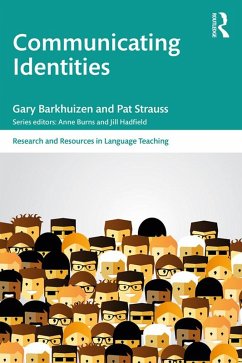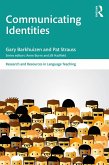40,95 €
40,95 €
inkl. MwSt.
Sofort per Download lieferbar

20 °P sammeln
40,95 €
Als Download kaufen

40,95 €
inkl. MwSt.
Sofort per Download lieferbar

20 °P sammeln
Jetzt verschenken
Alle Infos zum eBook verschenken
40,95 €
inkl. MwSt.
Sofort per Download lieferbar
Alle Infos zum eBook verschenken

20 °P sammeln
- Format: ePub
- Merkliste
- Auf die Merkliste
- Bewerten Bewerten
- Teilen
- Produkt teilen
- Produkterinnerung
- Produkterinnerung

Bitte loggen Sie sich zunächst in Ihr Kundenkonto ein oder registrieren Sie sich bei
bücher.de, um das eBook-Abo tolino select nutzen zu können.
Hier können Sie sich einloggen
Hier können Sie sich einloggen
Sie sind bereits eingeloggt. Klicken Sie auf 2. tolino select Abo, um fortzufahren.

Bitte loggen Sie sich zunächst in Ihr Kundenkonto ein oder registrieren Sie sich bei bücher.de, um das eBook-Abo tolino select nutzen zu können.
Communicating Identities is a book for language teachers who wish to focus on the topic of identity in the context of their classroom teaching. The book provides a set of interactive, practical activities for use in language classrooms in which students explore and communicate about aspects of their identities.
- Geräte: eReader
- ohne Kopierschutz
- eBook Hilfe
- Größe: 2.44MB
Andere Kunden interessierten sich auch für
![Communicating Identities (eBook, PDF) Communicating Identities (eBook, PDF)]() Gary BarkhuizenCommunicating Identities (eBook, PDF)40,95 €
Gary BarkhuizenCommunicating Identities (eBook, PDF)40,95 €![Teaching and Researching Writing (eBook, ePUB) Teaching and Researching Writing (eBook, ePUB)]() Ken HylandTeaching and Researching Writing (eBook, ePUB)37,95 €
Ken HylandTeaching and Researching Writing (eBook, ePUB)37,95 €![Qualitative Research Topics in Language Teacher Education (eBook, ePUB) Qualitative Research Topics in Language Teacher Education (eBook, ePUB)]() Qualitative Research Topics in Language Teacher Education (eBook, ePUB)42,95 €
Qualitative Research Topics in Language Teacher Education (eBook, ePUB)42,95 €![Analysing Discourses in Teacher Observation Feedback Conferences (eBook, ePUB) Analysing Discourses in Teacher Observation Feedback Conferences (eBook, ePUB)]() Fiona CoplandAnalysing Discourses in Teacher Observation Feedback Conferences (eBook, ePUB)40,95 €
Fiona CoplandAnalysing Discourses in Teacher Observation Feedback Conferences (eBook, ePUB)40,95 €![Autonomy in Language Education (eBook, ePUB) Autonomy in Language Education (eBook, ePUB)]() Manuel Jimenez RayaAutonomy in Language Education (eBook, ePUB)42,95 €
Manuel Jimenez RayaAutonomy in Language Education (eBook, ePUB)42,95 €![Teaching and Researching: Autonomy in Language Learning (eBook, ePUB) Teaching and Researching: Autonomy in Language Learning (eBook, ePUB)]() Phil BensonTeaching and Researching: Autonomy in Language Learning (eBook, ePUB)39,95 €
Phil BensonTeaching and Researching: Autonomy in Language Learning (eBook, ePUB)39,95 €![Capital, Commodity, and English Language Teaching (eBook, ePUB) Capital, Commodity, and English Language Teaching (eBook, ePUB)]() William SimpsonCapital, Commodity, and English Language Teaching (eBook, ePUB)39,95 €
William SimpsonCapital, Commodity, and English Language Teaching (eBook, ePUB)39,95 €-
-
-
Communicating Identities is a book for language teachers who wish to focus on the topic of identity in the context of their classroom teaching. The book provides a set of interactive, practical activities for use in language classrooms in which students explore and communicate about aspects of their identities.
Dieser Download kann aus rechtlichen Gründen nur mit Rechnungsadresse in A, B, BG, CY, CZ, D, DK, EW, E, FIN, F, GR, HR, H, IRL, I, LT, L, LR, M, NL, PL, P, R, S, SLO, SK ausgeliefert werden.
Produktdetails
- Produktdetails
- Verlag: Taylor & Francis eBooks
- Seitenzahl: 286
- Erscheinungstermin: 18. März 2020
- Englisch
- ISBN-13: 9781351586689
- Artikelnr.: 58930757
- Verlag: Taylor & Francis eBooks
- Seitenzahl: 286
- Erscheinungstermin: 18. März 2020
- Englisch
- ISBN-13: 9781351586689
- Artikelnr.: 58930757
- Herstellerkennzeichnung Die Herstellerinformationen sind derzeit nicht verfügbar.
Gary Barkhuizen is professor of applied linguistics at the University of Auckland, New Zealand. His teaching and research interests are in the areas of language teacher education, teacher and learner identity, study abroad, and narrative inquiry. He is editor of Reflections on Language Teacher Identity Research (Routledge, 2017) and Qualitative Research Topics in Language Teacher Education (Routledge, 2019).
Pat Strauss is associate professor at Auckland University of Technology, New Zealand. Her teaching and research interests include academic writing, student and teacher identity, language teacher education, and English for research and publication purposes.
Pat Strauss is associate professor at Auckland University of Technology, New Zealand. Her teaching and research interests include academic writing, student and teacher identity, language teacher education, and English for research and publication purposes.
Acknowledgements
Part 1 - From Research to Implications
A. Introduction
B. Organization of Part 1
C. Starting with the Big Issues
D. Conceptualizing Language Learner Identity
E. Conceptualizing Language Teacher Identity
F. Implications of Identity Research for Application
G. Looking Ahead: Communicating Identities
Part 2 - From Implications to Application
A. Introduction
B. Reflexing Identities
Activity 1: This is (not) like me
Activity 2: Celebrating birthdays
Activity 3: What makes me me?
Activity 4: Tweeting
Activity 5: Memories and smells
Activity 6: Maps of the world
Activity 7: Using our brains!
Activity 8: The gender of objects
Activity 9: Food and identity
Activity 10: Author presence
Activity 11: Chickens in cages
Activity 12: My ideal holiday
C. Projecting Identities
Activity 13: Introducing ourselves
Activity 14: What's in a name?
Activity 15: Gay men playing rugby
Activity 16: Relationships and age
Activity 17: The clothes we wear
Activity 18: Why is Facebook so popular?
Activity 19: Idiomatic language
Activity 20: Make your own cartoon
Activity 21: There's a little bit of good in everyone
Activity 22: Proverbs and you
Activity 23: Justifying your opinion
Activity 24: Pictures at an exhibition
D. Recognizing Identities
Activity 25: A good friend
Activity 26: Who are these women?
Activity 27: Film critic
Activity 28: Identity theft
Activity 29: Teacher roles
Activity 30: Gendered identities in occupations
Activity 31: Stereotyping
Activity 32: Questioning national identities
Activity 33: Designing a questionnaire
Activity 34: Writing a report
Activity 35: No laughing matter
Activity 36: The language of ads
E. Imagining Identities
Activity 37: What kind of wild animal?
Activity 38: Me flying high
Activity 39: My dream room
Activity 40: Names for (online) gamers
Activity 41: The aliens have landed
Activity 42: Speaking English tomorrow
Activity 43: Identity quotes
Activity 44: Different perspectives
Activity 45: What makes them them?
Activity 46: Social justice and advertising
Activity 47: Consumer identity
Activity 48: Transport of the future
Part 3 - From Application to Implementation
A. Introduction
B. Organization of Part 3
C. Characteristics of the Curriculum
D. Planning Activities
E. Implementing Activities in the Classroom
F. What Should We Do After the Activities?
Part 4 - From Implementation to Research
A. Introduction
B. Organization of Part 4
C. What is Exploratory Action Research?
D. Selecting Topics to Explore
E. Gathering Information
F. Narrative Inquiry
G. Making Sense of the Information Gathered
H. Sharing Your Findings
I. Conclusion
References
Index
Part 1 - From Research to Implications
A. Introduction
B. Organization of Part 1
C. Starting with the Big Issues
D. Conceptualizing Language Learner Identity
E. Conceptualizing Language Teacher Identity
F. Implications of Identity Research for Application
G. Looking Ahead: Communicating Identities
Part 2 - From Implications to Application
A. Introduction
B. Reflexing Identities
Activity 1: This is (not) like me
Activity 2: Celebrating birthdays
Activity 3: What makes me me?
Activity 4: Tweeting
Activity 5: Memories and smells
Activity 6: Maps of the world
Activity 7: Using our brains!
Activity 8: The gender of objects
Activity 9: Food and identity
Activity 10: Author presence
Activity 11: Chickens in cages
Activity 12: My ideal holiday
C. Projecting Identities
Activity 13: Introducing ourselves
Activity 14: What's in a name?
Activity 15: Gay men playing rugby
Activity 16: Relationships and age
Activity 17: The clothes we wear
Activity 18: Why is Facebook so popular?
Activity 19: Idiomatic language
Activity 20: Make your own cartoon
Activity 21: There's a little bit of good in everyone
Activity 22: Proverbs and you
Activity 23: Justifying your opinion
Activity 24: Pictures at an exhibition
D. Recognizing Identities
Activity 25: A good friend
Activity 26: Who are these women?
Activity 27: Film critic
Activity 28: Identity theft
Activity 29: Teacher roles
Activity 30: Gendered identities in occupations
Activity 31: Stereotyping
Activity 32: Questioning national identities
Activity 33: Designing a questionnaire
Activity 34: Writing a report
Activity 35: No laughing matter
Activity 36: The language of ads
E. Imagining Identities
Activity 37: What kind of wild animal?
Activity 38: Me flying high
Activity 39: My dream room
Activity 40: Names for (online) gamers
Activity 41: The aliens have landed
Activity 42: Speaking English tomorrow
Activity 43: Identity quotes
Activity 44: Different perspectives
Activity 45: What makes them them?
Activity 46: Social justice and advertising
Activity 47: Consumer identity
Activity 48: Transport of the future
Part 3 - From Application to Implementation
A. Introduction
B. Organization of Part 3
C. Characteristics of the Curriculum
D. Planning Activities
E. Implementing Activities in the Classroom
F. What Should We Do After the Activities?
Part 4 - From Implementation to Research
A. Introduction
B. Organization of Part 4
C. What is Exploratory Action Research?
D. Selecting Topics to Explore
E. Gathering Information
F. Narrative Inquiry
G. Making Sense of the Information Gathered
H. Sharing Your Findings
I. Conclusion
References
Index
Acknowledgements
Part 1 - From Research to Implications
A. Introduction
B. Organization of Part 1
C. Starting with the Big Issues
D. Conceptualizing Language Learner Identity
E. Conceptualizing Language Teacher Identity
F. Implications of Identity Research for Application
G. Looking Ahead: Communicating Identities
Part 2 - From Implications to Application
A. Introduction
B. Reflexing Identities
Activity 1: This is (not) like me
Activity 2: Celebrating birthdays
Activity 3: What makes me me?
Activity 4: Tweeting
Activity 5: Memories and smells
Activity 6: Maps of the world
Activity 7: Using our brains!
Activity 8: The gender of objects
Activity 9: Food and identity
Activity 10: Author presence
Activity 11: Chickens in cages
Activity 12: My ideal holiday
C. Projecting Identities
Activity 13: Introducing ourselves
Activity 14: What's in a name?
Activity 15: Gay men playing rugby
Activity 16: Relationships and age
Activity 17: The clothes we wear
Activity 18: Why is Facebook so popular?
Activity 19: Idiomatic language
Activity 20: Make your own cartoon
Activity 21: There's a little bit of good in everyone
Activity 22: Proverbs and you
Activity 23: Justifying your opinion
Activity 24: Pictures at an exhibition
D. Recognizing Identities
Activity 25: A good friend
Activity 26: Who are these women?
Activity 27: Film critic
Activity 28: Identity theft
Activity 29: Teacher roles
Activity 30: Gendered identities in occupations
Activity 31: Stereotyping
Activity 32: Questioning national identities
Activity 33: Designing a questionnaire
Activity 34: Writing a report
Activity 35: No laughing matter
Activity 36: The language of ads
E. Imagining Identities
Activity 37: What kind of wild animal?
Activity 38: Me flying high
Activity 39: My dream room
Activity 40: Names for (online) gamers
Activity 41: The aliens have landed
Activity 42: Speaking English tomorrow
Activity 43: Identity quotes
Activity 44: Different perspectives
Activity 45: What makes them them?
Activity 46: Social justice and advertising
Activity 47: Consumer identity
Activity 48: Transport of the future
Part 3 - From Application to Implementation
A. Introduction
B. Organization of Part 3
C. Characteristics of the Curriculum
D. Planning Activities
E. Implementing Activities in the Classroom
F. What Should We Do After the Activities?
Part 4 - From Implementation to Research
A. Introduction
B. Organization of Part 4
C. What is Exploratory Action Research?
D. Selecting Topics to Explore
E. Gathering Information
F. Narrative Inquiry
G. Making Sense of the Information Gathered
H. Sharing Your Findings
I. Conclusion
References
Index
Part 1 - From Research to Implications
A. Introduction
B. Organization of Part 1
C. Starting with the Big Issues
D. Conceptualizing Language Learner Identity
E. Conceptualizing Language Teacher Identity
F. Implications of Identity Research for Application
G. Looking Ahead: Communicating Identities
Part 2 - From Implications to Application
A. Introduction
B. Reflexing Identities
Activity 1: This is (not) like me
Activity 2: Celebrating birthdays
Activity 3: What makes me me?
Activity 4: Tweeting
Activity 5: Memories and smells
Activity 6: Maps of the world
Activity 7: Using our brains!
Activity 8: The gender of objects
Activity 9: Food and identity
Activity 10: Author presence
Activity 11: Chickens in cages
Activity 12: My ideal holiday
C. Projecting Identities
Activity 13: Introducing ourselves
Activity 14: What's in a name?
Activity 15: Gay men playing rugby
Activity 16: Relationships and age
Activity 17: The clothes we wear
Activity 18: Why is Facebook so popular?
Activity 19: Idiomatic language
Activity 20: Make your own cartoon
Activity 21: There's a little bit of good in everyone
Activity 22: Proverbs and you
Activity 23: Justifying your opinion
Activity 24: Pictures at an exhibition
D. Recognizing Identities
Activity 25: A good friend
Activity 26: Who are these women?
Activity 27: Film critic
Activity 28: Identity theft
Activity 29: Teacher roles
Activity 30: Gendered identities in occupations
Activity 31: Stereotyping
Activity 32: Questioning national identities
Activity 33: Designing a questionnaire
Activity 34: Writing a report
Activity 35: No laughing matter
Activity 36: The language of ads
E. Imagining Identities
Activity 37: What kind of wild animal?
Activity 38: Me flying high
Activity 39: My dream room
Activity 40: Names for (online) gamers
Activity 41: The aliens have landed
Activity 42: Speaking English tomorrow
Activity 43: Identity quotes
Activity 44: Different perspectives
Activity 45: What makes them them?
Activity 46: Social justice and advertising
Activity 47: Consumer identity
Activity 48: Transport of the future
Part 3 - From Application to Implementation
A. Introduction
B. Organization of Part 3
C. Characteristics of the Curriculum
D. Planning Activities
E. Implementing Activities in the Classroom
F. What Should We Do After the Activities?
Part 4 - From Implementation to Research
A. Introduction
B. Organization of Part 4
C. What is Exploratory Action Research?
D. Selecting Topics to Explore
E. Gathering Information
F. Narrative Inquiry
G. Making Sense of the Information Gathered
H. Sharing Your Findings
I. Conclusion
References
Index







